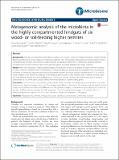| dc.contributor.author | Karen Rossmassler, Carsten Dietrich, Claire Thompson, Aram Mikaelyan, James O Nonoh, Rudolf H Scheffrahn, David Sillam-Dussès, Andreas Brune | |
| dc.date.accessioned | 2020-07-29T07:09:49Z | |
| dc.date.available | 2020-07-29T07:09:49Z | |
| dc.date.issued | 2015-12-01 | |
| dc.identifier.uri | https://repository.maseno.ac.ke/handle/123456789/1650 | |
| dc.description.abstract | Termites are important contributors to carbon and nitrogen cycling in tropical ecosystems. Higher termites digest lignocellulose in various stages of humification with the help of an entirely prokaryotic microbiota housed in their compartmented intestinal tract. Previous studies revealed fundamental differences in community structure between compartments, but the functional roles of individual lineages in symbiotic digestion are mostly unknown.
Results
Here, we conducted a highly resolved analysis of the gut microbiota in six species of higher termites that feed on plant material at different levels of humification. Combining amplicon sequencing and metagenomics, we assessed similarities in community structure and functional potential between the major hindgut compartments (P1, P3, and P4). Cluster analysis of the relative abundances of orthologous gene clusters (COGs) revealed high similarities among wood- and litter-feeding termites and strong differences to humivorous species. However, abundance estimates of bacterial phyla based on 16S rRNA genes greatly differed from those based on protein-coding genes.
Conclusion
Community structure and functional potential of the microbiota in individual gut compartments are clearly driven by the digestive strategy of the host. The metagenomics libraries obtained in this study provide the basis for future studies that elucidate the fundamental differences in the symbiont-mediated breakdown of lignocellulose and humus by termites of different feeding groups. The high proportion of uncultured bacterial lineages in all samples calls for a reference-independent approach for the correct taxonomic assignment of protein-coding genes. | en_US |
| dc.publisher | BioMed Central | en_US |
| dc.subject | Metagenomics, Termites, Hindgut, Functional potential, Gut microbiota, Community structure | en_US |
| dc.title | Metagenomic analysis of the microbiota in the highly compartmented hindguts of six wood-or soil-feeding higher termites | en_US |
| dc.type | Article | en_US |

